The EGO – nothing to Eliminate
| Ulrike Manhart
The Ego from my personal yoga therapeutical point of view.
Overcoming the Ego is a popular topic in the spiritual scene.
I am sure you have heard the sentence:
„Ego is a wonderful servant but not often a good master.“
There are millions of quotes out there that point to the Ego as the root of suffering. In this Blog I give you some ideas to provoke your Believe-system.
Why is it a part of us that we reject? Why do we blame the EGO for all the bad & suffering in the world? And in our own lives?
A little introduction in some theoretical definitions of what the Ego is:
Freud’s personality theory (1923) saw the psyche structured into three parts. The ID, EGO, and SUPEREGO. These are systems, not parts of the brain, or in any way physical.
According to Freud’s psychoanalytic theory, the ID is the primitive and instinctual part of the mind that contains sexual and aggressive drives and hidden memories, the Superego operates as a moral conscience, and the ego is the realistic part that mediates between the desires of the Id and the Superego.
Although each part of the personality comprises unique features, they interact to form a whole, and each part makes a relative contribution to an individual’s behavior. So this forms let’s call it a divine Trinity.
“The ego is “that part of the ID which has been modified by the direct influence of the external world.” (Freud, 1923, p. 25)
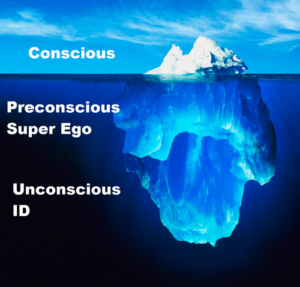
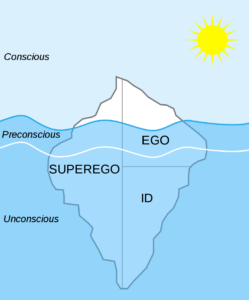
The Iceberg Modells from the 20ies.
What is the Ego exactly and what does the Ego?
The ego is the personality component responsible for dealing with reality.
The ego functions in the conscious, preconscious, and unconscious mind.
„The EGO is the only part of the conscious personality. It’s what the person is aware of when they think about themselves, and is what they usually try to project toward others. The EGO develops to mediate between the unrealistic ID and the external real world. It is the decision-making component of personality. Ideally, the EGO works by reason, whereas the ID is chaotic and unreasonable. The EGO operates according to the reality principle, working out realistic ways of satisfying the ID’s demands, often compromising or postponing satisfaction to avoid negative consequences of society. The EGO considers social realities and norms, etiquette and rules in deciding how to behave.“
Freud, S. (1923). The ego and the id. SE, 19: 1-66.
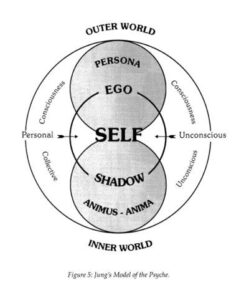
„Jung saw the ego as the centre of the field of consciousness which contains our conscious awareness of existing and a continuing sense of personal identity. It is the organiser of our thoughts and intuitions, feelings, and sensations, and has access to memories which are not repressed.“
The Vedic View:
Each human being has an ego or sense of separate self based upon our identification with the physical body that is rooted in our karma. This human ego at an intellectual level can be strong, even when it is sophisticated or well educated. Ego is the basis of the mind, which is how we see the world from our own personal perspective, so we compulsively use our minds to justify the biases of the ego, whether individual or collective. Unless we learn how to meditate and question the ego-mind, we will remain caught in its whirlpools that lead us into conflict with the egos of others, which are also justified by the conclusions of their own minds.
We are all related Jivas in a vast and benefic universe, on our pilgrimage through time and space. While we must face the consequences of our karmas, we are not limited to who we are in any single birth. Our inner being moves through all of nature, in the stars, planets, atmosphere, mountains, oceans, forests, and every sort of creaturely manifestation from plants to devas. The Jivatman has a higher intelligence born of its sense of eternal existence and relationship with the universe as a whole. We must learn to awaken that higher intelligence called the sattvic buddhi in Vedantic thought. We must recognize that we have many bodies in many births in many different worlds, and that also all worlds and creatures are inherent within us.
Our true Self, which is unity consciousness, is the only enduring basis for harmony and happiness in life and society. But to discover that we must look beyond the ego, the me and the mine, with its physical, mental and social limitations, to the real source of consciousness within us that is the inner light of Being.
Each one of us has a powerful sense of self, but we must remember that ultimately the true sense of Self-being is universal, not simply our personal identification with body and mind. We must expand our sense of Self beyond body and mind, society or even history, to embrace the greater Self-aware universe where differences in name and forms are but waves on a boundless ocean of unity, Brahman, the cosmic and transcendent reality.
So the definition of Ego in the yoga world:
Ego (ahamkara) is defined as the individual’s sense of who they are – their thoughts, desires and personality, as shaped by the mind. It is sometimes referred to as the “false self,” because it is colored only by one’s view of the world.
The Bhagavad Gita says:
Ahaṁkāra (Sanskrit: अहंकार), ‘I-making’ is a Sanskrit term in Saṃkhyā philosophy that refers to the identification of Self or Being with ‘Nature’ or any impermanent ‘thing’. It is referred to as ego and evolves from Mahat-tattva, It is one of the four Antaḥkaraṇa (functions of the mind).
Osho says:
“You cannot drop the ego. Once you start trying to drop the ego you will get in a very deep mess; you will become more and more worried and puzzled. And this is not the way to get rid of the ego. The only way to get rid of the ego is to look at it.”
Sadhguru:
„Non-acceptance is a form of anger and wanting changes is form of Ego.“
Swami Vivekananda:
“The “ego” like its correlative “non-ego”, is the product of the body, mind etc. The only proof of the existence of the real Self is realisation.”
Yogananda:
He defined the ego as “the soul identified with the body.” Since we have 3 bodies (physical, astral, and causal). Same concept as Ram Dass and many others.
Sri Ramana Maharshi
Ego is I-thought. True ‘I’ is the Self.
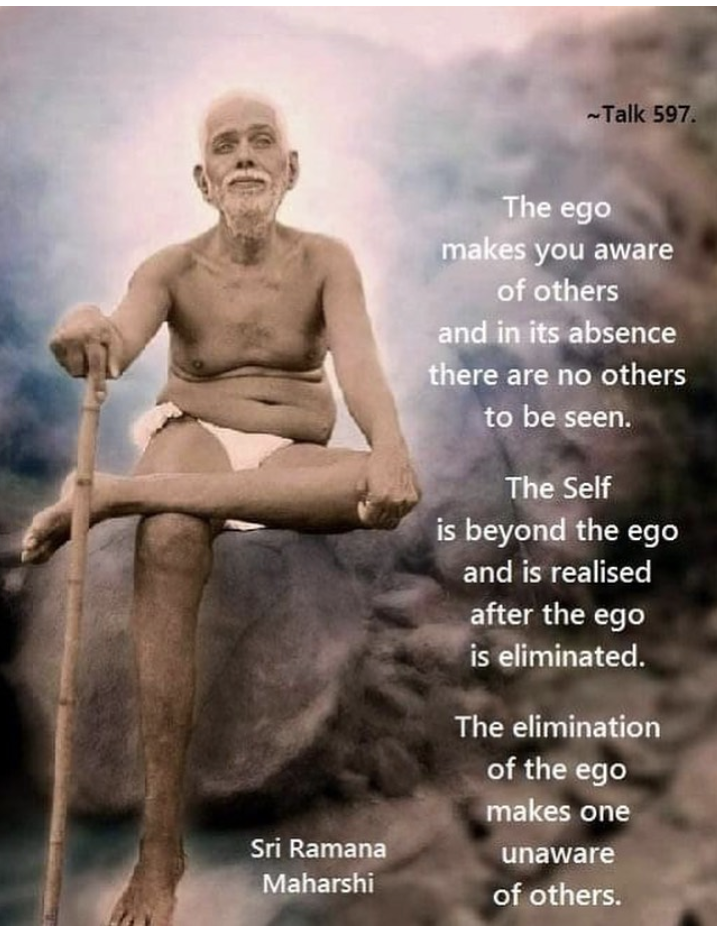
Yes there flows the saying in: There are no others. More to it later. I know it is confusing. The same like I am god and I am praying to God. So what?
The Samkhya Philosophy of Patanjali
In the Samkhya Indian school of philosophy – linked to Patanjali’s Yoga Sutras – the universe is seen as being divided up into two aspects: Prakriti and Purusha, or ‘manifest’ and ‘unmanifest’.
In this philosophy, Prakriti is seen as ‘creation’ or ‘matter’ and there are 25 ways Prakriti comes into being, most notably the mind, the senses, the body, the elements and the material world. Purusha is often known as the ‘divine essence’, the energy that is unmanifest and cannot be seen even with the smallest telescope.
The Yoga Sutras state that when we experience Avidya (ignorance) we often believe or become tangled up in all the thoughts we experience in the mind. We confuse our true self – the most pure essence – with the ego and we get pushed and pulled around by the storms of the mind, also known as ‘Maya’ (Illusion).
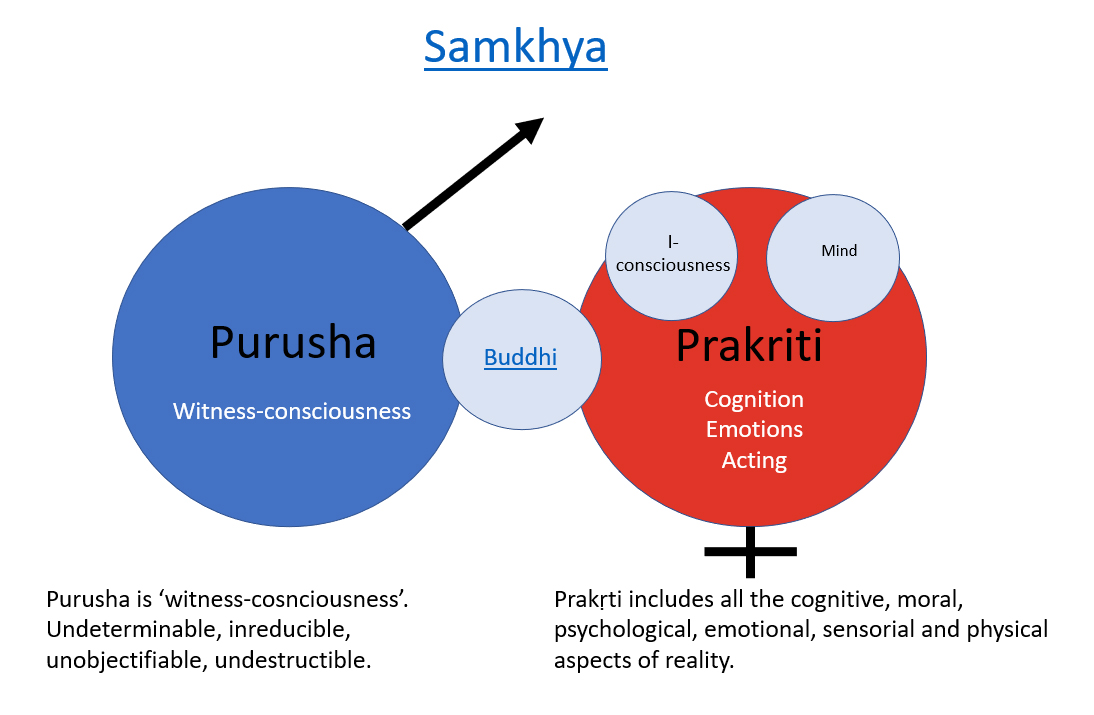
So if we say somebody has a big Ego: What does it mean?
I believe there is a huge confusion about the EGO. If we say someone has a ‘big ego’ this essentially means that they identify a little too closely with their story, their body and their BEING. To have a ‘big ego’ does not necessarily mean to be overly confident and abrasive, it can refer to the over-attachment to ‘I, Me, My’.
In my opinion „Fuck it“:
You are more than able to look behind all these limitations ……The Ego isn’t responsible or holding you back from it. What is holding you back is the fact that you think that your are separate from the unity consciousness, from all that is. This happens in the moment when you are taking your first Inhale. It’s not the ego that’s the problem, it’s our over-identification with, and attachment to, the story that comes with it.
Also the fact that the Ego fears Death. Something in our body must keep us alive. What would keep us alive? The Organs? The Fear of Death is a complete other Topic and has not a seed to do with the Ego.
Psychologist Pelin Kesebir argues that a much more constructive and healthier way of dealing with death anxiety is through Humility. Across five studies, Pelin Kesebir tested the idea that high levels of humility (measured both as a trait and as a state of being) would be associated with lower death anxiety and lower defensiveness in the face of death thoughts. First, she found that high levels of humility and low levels of entitlement were associated with lower levels of death anxiety and anxiety-induced defensiveness. Humility warded off death anxiety more than qualities such as high self-esteem, mindfulness, general virtuousness, and even having a secure attachment style.
Back to another concept:
In Theta Healing the Concept is about the Planes of Existence by Vianna Stibal: There are seven planes.
7th Creation/Source
6th Universal Laws
5th Guides/Angels/Ascended Masters
4th Spirit
3rd Our Reality
2nd Organic Material
1st In-organic Material
Ram Dass is Teaching the 3 planes of existence:
One system through which you can look at it all, is that there are a set of vibrations or frequencies, you can call them the physical plane, the astral plane, the causal plane, and that which is beyond the beyond.
In Buddhism they talk about 31 Planes/Dimensions.
THE TAO talk about the 7 planes too:
the physical, astral, causal, akashic, mental, messianic and buddhaic planes
„The concept of matter expanding is from Mark MuCutcheon’s The Final Theory. Just as matter is expanding vibration in the etheric field, the waves created by matter in the etheric themselves create waves in each subsequent field into which each lower plane field is impeded. The number of the individual planes is not known by science at the current time, as the theory is too new, however the ancient Egyptians had developed a system consisting of 42 subplanes within 7 major planes (John Gordon’s Egypt: Child of Atlantis).“
The list is endless. The Shaman´s & indogen Cultures of are believing as well in different planes of existence concepts.
Why I was opening with the Planes on this topic?
By working at the highest Plane directly from Source, THIS:
* eliminates unhealthy Ego and Sickness
* is without dualistic Perception…it’s unity and unifying
* eliminates Fear
* is anyway beyond Death
* allows us to know the Highest Truth & Live our highest Purpose because Source is working through us in a high frequency
My true opinion about the EGO:
IT IS DEEPLY HELPFUL!
IT HAS A VERY IMPORTANT TASK TO INTERACT & CONNECT IN OUR LIFE!
We must not get rid of the Ego. It is more about the realization „WHO THINKS!“
The ego is used in all the teachings as an example to recognize the separation and thus dissolve it.
And from my more than 20 years of work as a therapist and more than 13 years as a yoga teacher I can say. A healthy ego is enormously important to set healthy boundaries. And yes an ego can survive without desires.
We can use our ego to identify ourselves. It helps us see ourselves as part of the greater whole and dissolve separation.
Ego is one of our greatest Strength and our greatest weakness. It can chase us up and it can deeply sabotage us. Ego gives us the power to tackle the things we are afraid of. It is directly related to willpower and helps us reprogram just about everything in our system. It gives us resilience when things go wrong. It helps us grow. In what direction we are free to choose.
So, why not use our ego to grow into our highest potential?
Here is our task. When you look back on the iceberg modell through the EGO we are able to make the Conscious Part (The top of the Iceberg) BIGGER.
Rumi said: „The wings of humankind is its aspiration.”
Another good trait of the Ego is our Vulnerability. It helps us to forgive and to say „Sorry“. It helps us to communicate our current status. So it is a big help to be empathic to each other and understand the situation your vis-a-vis is in.
Neither Buddhism nor Psychotherapy seeks to eradicate the ego.
To do so would leave us helpless or psychotic. We need our egos to navigate the world, to regulate our instincts and to mediate the conflicting demands of self and the „others“. The therapeutic practices of both Buddhism and Psychotherapy are often used to build up the ego. When someone is depressed or suffers from low self-esteem because he or she has been mistreated, for example, therapy must focus on repairing the ego. I find it very useful to strengthen the self-love, Self-awareness, Faith, Learning to set healthy Boundaries etc. extremely important to have an EGO that is able to be programmed in a new way. A new Program of Mind & EGO that we can dive into a higher consciousness. Raising Consciousness and taking the unconsious mind the Leadership.
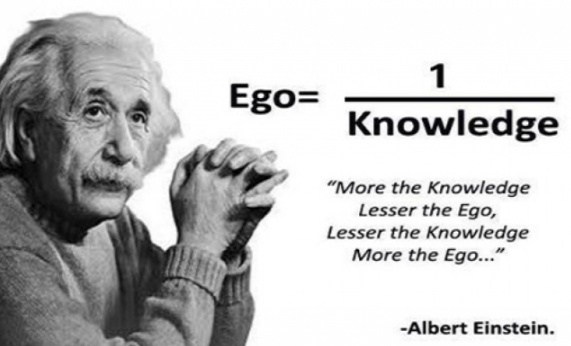
I understand the other unhealthy side. When arrogance and the „ME“ take a lot of space. It makes us small when we interact which such kind of persons. Why? Because our Ego doesn’t like it. We like confidence but we don’t like arrogance. It would be an interesting look into it where does confidence end and arrogance begin?
„Confidence ends and arrogance begins when you fail to see past yourself“ said one of my beloved followers.
Google says: Confidence becomes arrogance when perspective is lost and an individual loses humility. – Interesting wise here closes the circle with Humility and the Fear of Death. Confident individuals see themselves and their abilities as significant while arrogant individuals see themselves and their abilities as superior.
Where are our personal markers to judge someone as arrogant?
It works against us when we stay stucked in your 2D/3D Thinking. It works against us when it pushes us into Fear & Anxiety. Exactly here we DO and ACT for ourselves and all others around us. It shuts down our vulnerability and a dark loop begins. Blaming others and victim hood are also results of an unhealthy ego. Being aware of these self-sabotage programs is the first point and there is a way out. Unprogramming your mind.
There are mostly reasons for an unhealthy ego that is in defensiveness mode. Mostly to protect some „weakness“ or not feeling good enough. And so many other reasons. I am in a state that when I sense such behavior I open & expand myself so much that the other one feels safe and loved. And funny enough the other side stops to do the „arrogant“ – I am better than you – behavior. Arrogance is always rooted in insecurity. A defense from feelings of weakness that are unacceptable and unclaimed.
We bleed to the outside to protect something. I see in every encounter a spark of god and I deeply believe whatever comes into my direction serves me and my highest good. That means for the highest good of all.
And behaviors that you don’t like on others show you on the one hand:
A excluded part you haven’t integrated or loved enough in yourself. And on the second hand exactly the way you don’t want to be.
And here is one of my favorite Parts of the „Autobiography of a Yoga, in Chapter 43.
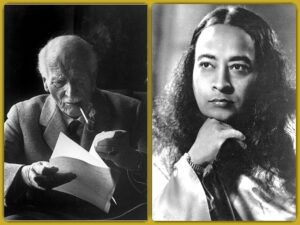
„The Resurrection of Sri Yukeeswar“. When the pysical body dies, what remains are the astral and causal bodies. Generally speaking, you begin at that point to dwell on some level of the astral plane.
As for the Ego, you do take it WITH YOU after physical Death, into the Astral plane. Yogananda defined the Ego as „ the soul identified with the body“.
Since we have 3 bodies (physical, astral and causal) and for as long as we have any sort of body, in order to exist within it, we must be attached to it, at least to some degree. So the ego can never cease to exist until it is completely relinquished the moment final liberation (ALL 3 BODIES ARE DISSOLVED AWAY). Astral body includes Chakras, Nadis, Aura, Koshas and so on.
When Jesus said: „The Kingdom of Heaven is within you.“. He was speaking of the soul that which is temporarily contained in the 3 bodies. Your spark of “All that is”.
Small Exercise:
Take some deep breaths and watch your thoughts that enter. Watch the thought as it enters your mind but (here’s the difficult part) do not become emotionally involved with it. Let them pass through like clouds on the sky. This is how we step into mindfulness. Learning to build up an internal warning system. And the realization of is this thought supporting the highest good of this world or not? Does it serve?
ALL IN ALL I deeply feel that the great sages use the Teachings of the Ego to lead you on the road to your true Essence and that we have to look beyond. We need a counterpart to realize what we are NOT.
Make peace with your Ego! Love it. Don’t push it away. It learns from your thoughts.You are an eternal Creator Being. Enjoy the ride and love every single cell and part of yourself. The Seen and Unseen.
If we dive deep enough into ourselves, we can find the thread of universal Love that ties the whole universe together.
Trust & Love,
Ulli

